Related Research Articles

A neutrino is a fermion that interacts only via the weak subatomic force and gravity. The neutrino is so named because it is electrically neutral and because its rest mass is so small (-ino) that it was long thought to be zero. The mass of the neutrino is much smaller than that of the other known elementary particles. The weak force has a very short range, the gravitational interaction is extremely weak, and neutrinos do not participate in the strong interaction. Thus, neutrinos typically pass through normal matter unimpeded and undetected.
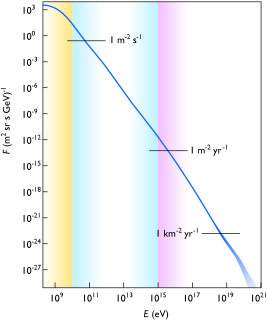
Cosmic rays are high-energy protons and atomic nuclei which move through space at nearly the speed of light. They originate from the sun, from outside of the solar system, and from distant galaxies. They were discovered by Victor Hess in 1912 in balloon experiments. Direct measurement of cosmic rays, especially at lower energies, has become possible since the launch of the first satellites in the late 1950s. Particle detectors similar to those used in nuclear and high-energy physics are used on satellites and space probes for research into cosmic rays. Upon impact with the Earth's atmosphere, cosmic rays can produce showers of secondary particles that sometimes reach the surface. Data from the Fermi Space Telescope (2013) have been interpreted as evidence that a significant fraction of primary cosmic rays originate from the supernova explosions of stars. Active galactic nuclei also appear to produce cosmic rays, based on observations of neutrinos and gamma rays from blazar TXS 0506+056 in 2018.
The Greisen–Zatsepin–Kuzmin limit (GZK limit) is a theoretical upper limit on the energy of cosmic ray protons traveling from other galaxies through the intergalactic medium to our galaxy. The limit is 5×1019 eV (50 EeV), or about 8 joules (the energy of a proton travelling at ≈99.99999999999999999998% the speed of light). The limit is set by slowing interactions of the protons with the microwave background radiation over long distances (≈160 million light-years). The limit is at the same order of magnitude as the upper limit for energy at which cosmic rays have experimentally been detected. For example, one extreme-energy cosmic ray, the Oh-My-God Particle, which has been found to possess a record-breaking 3.12×1020 eV (50 joules) of energy (about the same as the kinetic energy of a 95 km/h baseball).
In astroparticle physics, an ultra-high-energy cosmic ray (UHECR) is a cosmic ray with an energy greater than 1 EeV (1018 electronvolts, approximately 0.16 joules), far beyond both the rest mass and energies typical of other cosmic ray particles.

HEGRA, which stands for High-Energy-Gamma-Ray Astronomy, was an atmospheric Cherenkov telescope for Gamma-ray astronomy. With its various types of detectors, HEGRA took data between 1987 and 2002, at which point it was dismantled in order to build its successor, MAGIC, at the same site.

An air shower is an extensive cascade of ionized particles and electromagnetic radiation produced in the atmosphere when a primary cosmic ray enters the atmosphere. When a particle, which could be a proton, a nucleus, an electron, a photon, or (rarely) a positron, strikes an atom's nucleus in the air it produces many energetic hadrons. The unstable hadrons decay in the air speedily into other particles and electromagnetic radiation, which are part of the shower components. The secondary radiation rains down, including x-rays, muons, protons, antiprotons, alpha particles, pions, electrons, positrons, and neutrons.

The Pierre Auger Observatory is an international cosmic ray observatory in Argentina designed to detect ultra-high-energy cosmic rays: sub-atomic particles traveling nearly at the speed of light and each with energies beyond 1018 eV. In Earth's atmosphere such particles interact with air nuclei and produce various other particles. These effect particles (called an "air shower") can be detected and measured. But since these high energy particles have an estimated arrival rate of just 1 per km2 per century, the Auger Observatory has created a detection area of 3,000 km2 (1,200 sq mi)—the size of Rhode Island, or Luxembourg—in order to record a large number of these events. It is located in the western Mendoza Province, Argentina, near the Andes.

ALICE is one of eight detector experiments at the Large Hadron Collider at CERN. The other seven are: ATLAS, CMS, TOTEM, LHCb, LHCf, MoEDAL and FASER.

A neutrino detector is a physics apparatus which is designed to study neutrinos. Because neutrinos only weakly interact with other particles of matter, neutrino detectors must be very large to detect a significant number of neutrinos. Neutrino detectors are often built underground, to isolate the detector from cosmic rays and other background radiation. The field of neutrino astronomy is still very much in its infancy – the only confirmed extraterrestrial sources so far as of 2018 are the Sun and the supernova 1987A in the nearby Large Magellanic Cloud. Another likely source is the blazar TXS 0506+056 about 3.7 billion light years away. Neutrino observatories will "give astronomers fresh eyes with which to study the universe".
Electronic anticoincidence is a method widely used to suppress unwanted, "background" events in high energy physics, experimental particle physics, gamma-ray spectroscopy, gamma-ray astronomy, experimental nuclear physics, and related fields. In the typical case, a high-energy interaction, or event, that it is desired to study occurs and is detected by some kind of electronic detector, creating a fast electronic pulse in the associated nuclear electronics. But the desired events are mixed up with a significant number of other events, produced by other particles or other processes, which create indistinguishable events in the detector. Very often it is possible to arrange other physical photon or particle detectors to intercept the unwanted background events, producing essentially simultaneous pulses that can be used with fast electronics to reject, or veto, the unwanted background.
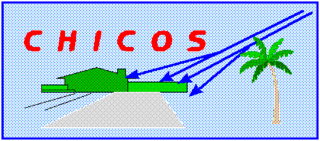
The California High School Cosmic Ray Observatory,, operated by the Kellogg Laboratory at the California Institute of Technology in Pasadena, California, United States, is one of the world's largest ongoing Cosmic Ray observatory programs. It is known for its large network within the Los Angeles County area, based mainly on high school sites carrying cosmic ray detector units, though there are also detector units on associated elementary schools and middle schools.
Astroparticle physics, also called particle astrophysics, is a branch of particle physics that studies elementary particles of astronomical origin and their relation to astrophysics and cosmology. It is a relatively new field of research emerging at the intersection of particle physics, astronomy, astrophysics, detector physics, relativity, solid state physics, and cosmology. Partly motivated by the discovery of neutrino oscillation, the field has undergone rapid development, both theoretically and experimentally, since the early 2000s.

The GRAPES-3 experiment located at Ooty in India started as a collaboration of the Indian Tata Institute of Fundamental Research and the Japanese Osaka City University, and now also includes the Japanese Nagoya Women's University.
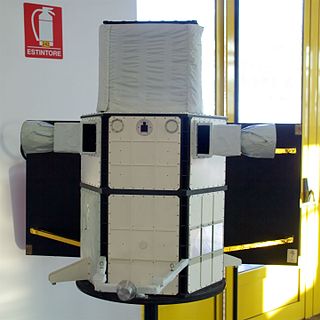
AGILE is an X-ray and Gamma ray astronomical satellite of the Italian Space Agency (ASI).
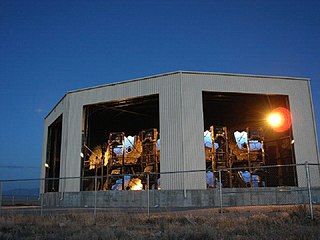
The Telescope Array project is an international collaboration involving research and educational institutions in Japan, The United States, Russia, South Korea, and Belgium. The experiment is designed to observe air showers induced by ultra-high-energy cosmic ray using a combination of ground array and air-fluorescence techniques. It is located in the high desert in Millard County, Utah (USA) at about 1,400 meters (4,600 ft) above sea level.
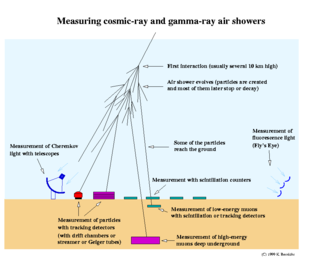
A cosmic-ray observatory is a scientific installation built to detect high-energy-particles coming from space called cosmic rays. This typically includes photons, electrons, protons, and some heavier nuclei, as well as antimatter particles. About 90% of cosmic rays are protons, 9% are alpha particles, and the remaining ~1% are other particles.

The High Altitude Water Cherenkov Experiment or High Altitude Water Cherenkov Observatory is a gamma-ray and cosmic ray observatory located on the flanks of the Sierra Negra volcano in the Mexican state of Puebla at an altitude of 4100 meters, at 18°59′41″N97°18′30.6″W. HAWC is the successor to the Milagro gamma-ray observatory in New Mexico, which was also a gamma-ray observatory based around the principle of detecting gamma-rays indirectly using the water Cherenkov method.
Cosmic Ray Energetics and Mass (CREAM) is an experiment to determine the composition of cosmic rays up to the 1015 eV (also known as the "knee prospect") in the cosmic ray spectrum.

The Accelerator Neutrino Neutron Interaction Experiment, abbreviated as ANNIE, is a proposed water Cherenkov detector experiment designed to examine the nature of neutrino interactions. This experiment will study phenomena like proton decay, and neutrino oscillations, by analyzing neutrino interactions in gadolinium-loaded water and measuring their neutron yield. Neutron Tagging plays an important role in background rejection from atmospheric neutrinos. By implementing early prototypes of LAPPDs, high precision timing is possible. The suggested location for ANNIE is the SciBooNE hall on the Booster Neutrino Beam associated with the MiniBooNE experiment. The neutrino beam originates in Fermilab where The Booster delivers 8 GeV protons to a beryllium target producing secondary pions and kaons. These secondary mesons decay to produce a neutrino beam with an average energy of around 800 MeV. ANNIE will begin installation in the summer of 2015. Phase I of ANNIE, mapping the neutron background, completed in 2017. The detector is being upgraded for full science operation which is expected to begin late 2018.
The Giant Radio Array for Neutrino Detection (GRAND) is a proposed large-scale detector designed to collect ultra-high energy cosmic particles as cosmic rays, neutrinos and photons with energies exceeding 1017 eV. This project aims at solving the mystery of their origin and the early stages of the universe itself. The proposal, formulated by an international group of researchers, calls for an array of 200,000 receivers to be placed on mountain ranges around the world.
References
- ↑ "NALTA: Cosmic Ray Physics with School-Based Detector Networks".
- ↑ Narlikar(1977), page 97.
- ↑ "Cosmic Rays - Richard Mewaldt".
- ↑ Griesen 1966, page 749.
- ↑ Linsley 1963, page 146.
- ↑ Yoshida, et al. 1995, page 105
- ↑ Abbasi, et al. 2008, page 1.
- ↑ "WALTA/NNODE Executive Summary".
- 1 2 "The Washington Large Area Time Coincidence Array" (PDF). neutrino.phys.washington.edu. 2016. Retrieved 2020-08-11.
- ↑ [ dead link ]
- ↑ Medina-Tanco 1999, page L91.